Decision Support Analysis: Tesco's Profitability in Recession Scenario
VerifiedAdded on 2023/03/31
|20
|3651
|83
Project
AI Summary
This project delves into the challenges faced by Tesco, a major UK retailer, during an economic recession. The study focuses on how declining economic growth impacts Tesco's profitability. To address this, the project employs system dynamics, constructing both analytical and simulation models to identify and evaluate solutions. It explores the impact of factors such as shipping costs, supplier relationships, and order quantities on sales and profit. The analytical model provides insights into the effects of variable changes, while the revised model incorporates mitigation strategies. The project concludes with a critical evaluation of both models and a discussion of how Tesco can navigate economic downturns by optimizing its supply chain and pricing strategies. The project also highlights the importance of decision variables and objective functions in business problem-solving.
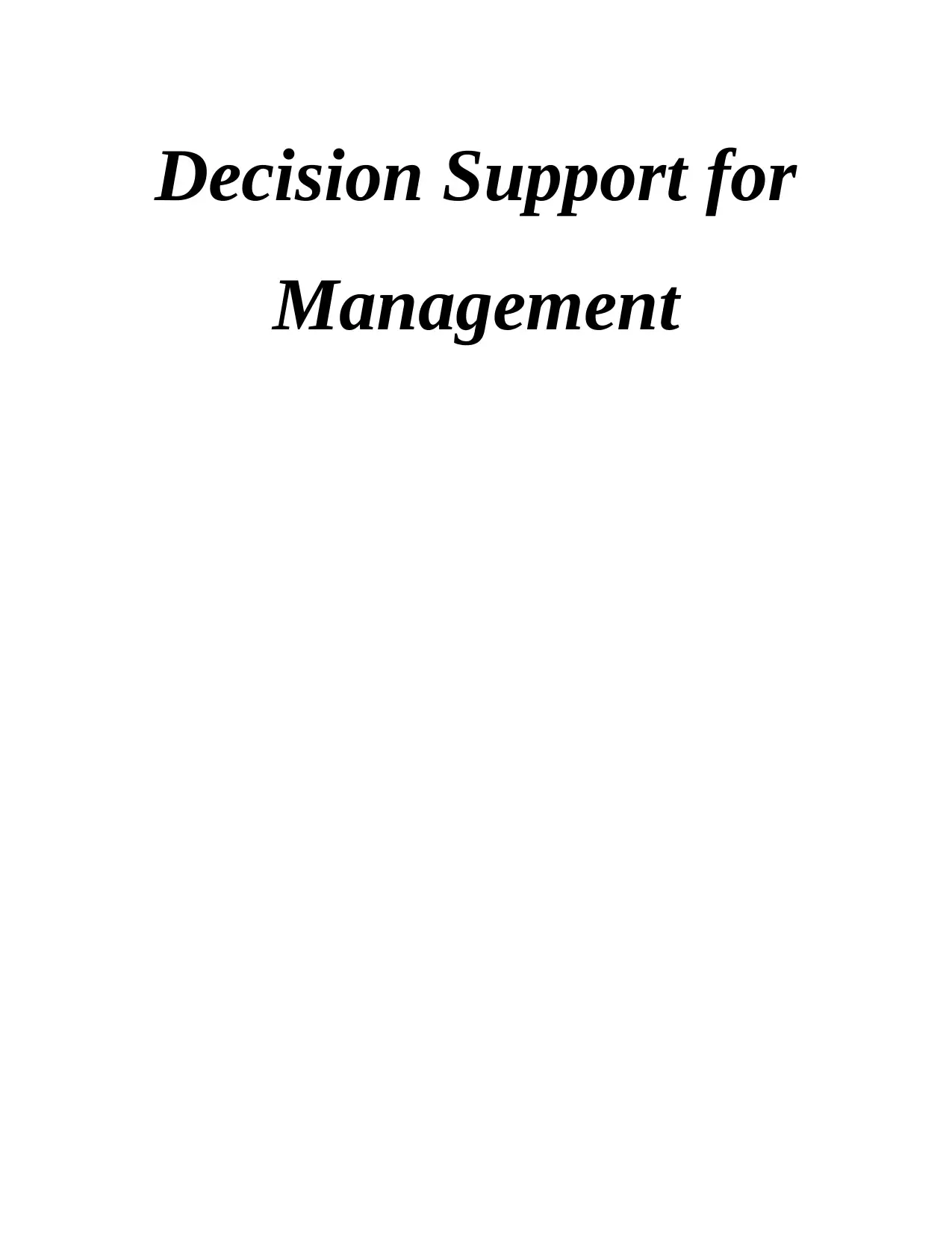
Decision Support for
Management
Management
Paraphrase This Document
Need a fresh take? Get an instant paraphrase of this document with our AI Paraphraser
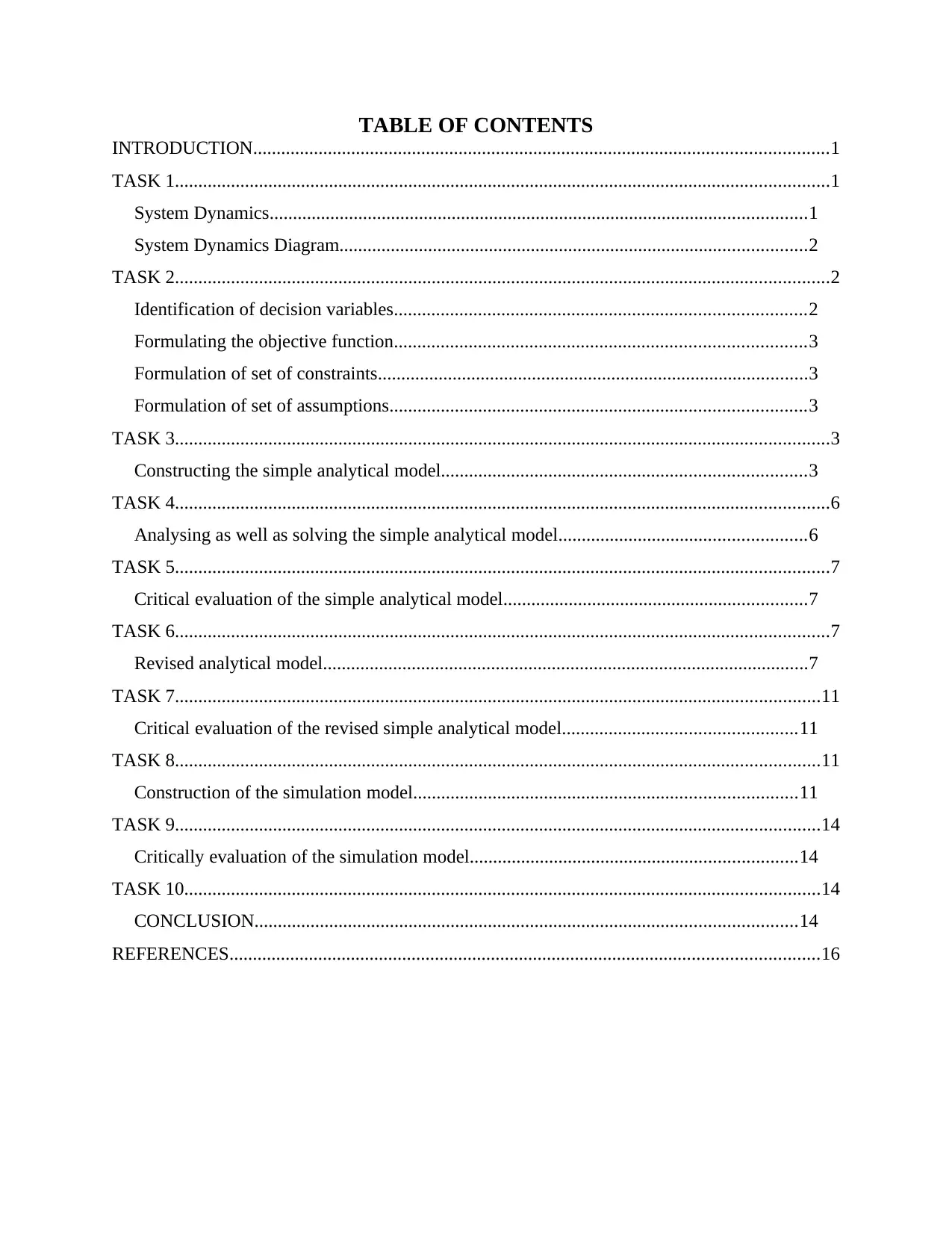
TABLE OF CONTENTS
INTRODUCTION...........................................................................................................................1
TASK 1............................................................................................................................................1
System Dynamics...................................................................................................................1
System Dynamics Diagram....................................................................................................2
TASK 2............................................................................................................................................2
Identification of decision variables........................................................................................2
Formulating the objective function........................................................................................3
Formulation of set of constraints............................................................................................3
Formulation of set of assumptions.........................................................................................3
TASK 3............................................................................................................................................3
Constructing the simple analytical model..............................................................................3
TASK 4............................................................................................................................................6
Analysing as well as solving the simple analytical model.....................................................6
TASK 5............................................................................................................................................7
Critical evaluation of the simple analytical model.................................................................7
TASK 6............................................................................................................................................7
Revised analytical model........................................................................................................7
TASK 7..........................................................................................................................................11
Critical evaluation of the revised simple analytical model..................................................11
TASK 8..........................................................................................................................................11
Construction of the simulation model..................................................................................11
TASK 9..........................................................................................................................................14
Critically evaluation of the simulation model......................................................................14
TASK 10........................................................................................................................................14
CONCLUSION....................................................................................................................14
REFERENCES..............................................................................................................................16
INTRODUCTION...........................................................................................................................1
TASK 1............................................................................................................................................1
System Dynamics...................................................................................................................1
System Dynamics Diagram....................................................................................................2
TASK 2............................................................................................................................................2
Identification of decision variables........................................................................................2
Formulating the objective function........................................................................................3
Formulation of set of constraints............................................................................................3
Formulation of set of assumptions.........................................................................................3
TASK 3............................................................................................................................................3
Constructing the simple analytical model..............................................................................3
TASK 4............................................................................................................................................6
Analysing as well as solving the simple analytical model.....................................................6
TASK 5............................................................................................................................................7
Critical evaluation of the simple analytical model.................................................................7
TASK 6............................................................................................................................................7
Revised analytical model........................................................................................................7
TASK 7..........................................................................................................................................11
Critical evaluation of the revised simple analytical model..................................................11
TASK 8..........................................................................................................................................11
Construction of the simulation model..................................................................................11
TASK 9..........................................................................................................................................14
Critically evaluation of the simulation model......................................................................14
TASK 10........................................................................................................................................14
CONCLUSION....................................................................................................................14
REFERENCES..............................................................................................................................16
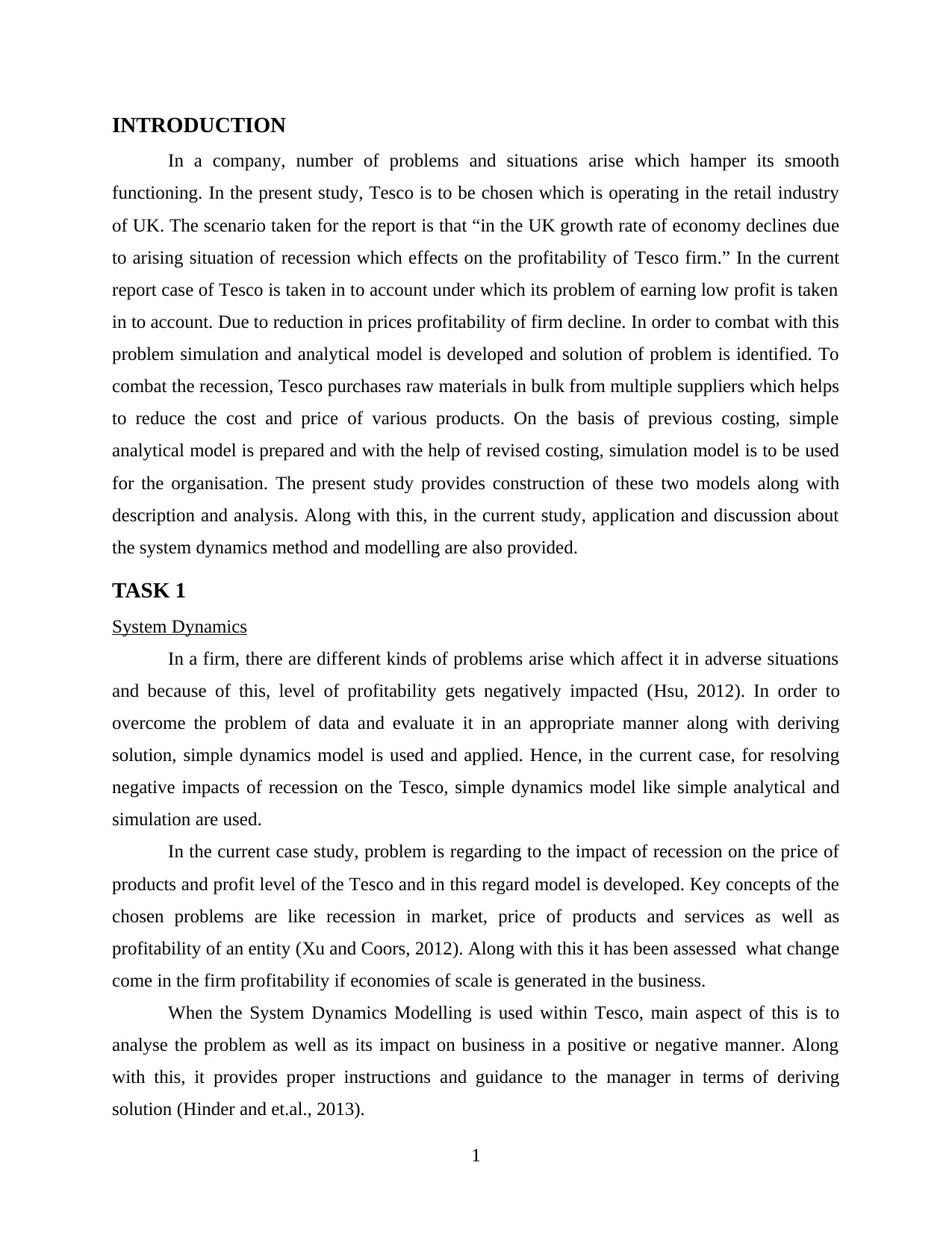
INTRODUCTION
In a company, number of problems and situations arise which hamper its smooth
functioning. In the present study, Tesco is to be chosen which is operating in the retail industry
of UK. The scenario taken for the report is that “in the UK growth rate of economy declines due
to arising situation of recession which effects on the profitability of Tesco firm.” In the current
report case of Tesco is taken in to account under which its problem of earning low profit is taken
in to account. Due to reduction in prices profitability of firm decline. In order to combat with this
problem simulation and analytical model is developed and solution of problem is identified. To
combat the recession, Tesco purchases raw materials in bulk from multiple suppliers which helps
to reduce the cost and price of various products. On the basis of previous costing, simple
analytical model is prepared and with the help of revised costing, simulation model is to be used
for the organisation. The present study provides construction of these two models along with
description and analysis. Along with this, in the current study, application and discussion about
the system dynamics method and modelling are also provided.
TASK 1
System Dynamics
In a firm, there are different kinds of problems arise which affect it in adverse situations
and because of this, level of profitability gets negatively impacted (Hsu, 2012). In order to
overcome the problem of data and evaluate it in an appropriate manner along with deriving
solution, simple dynamics model is used and applied. Hence, in the current case, for resolving
negative impacts of recession on the Tesco, simple dynamics model like simple analytical and
simulation are used.
In the current case study, problem is regarding to the impact of recession on the price of
products and profit level of the Tesco and in this regard model is developed. Key concepts of the
chosen problems are like recession in market, price of products and services as well as
profitability of an entity (Xu and Coors, 2012). Along with this it has been assessed what change
come in the firm profitability if economies of scale is generated in the business.
When the System Dynamics Modelling is used within Tesco, main aspect of this is to
analyse the problem as well as its impact on business in a positive or negative manner. Along
with this, it provides proper instructions and guidance to the manager in terms of deriving
solution (Hinder and et.al., 2013).
1
In a company, number of problems and situations arise which hamper its smooth
functioning. In the present study, Tesco is to be chosen which is operating in the retail industry
of UK. The scenario taken for the report is that “in the UK growth rate of economy declines due
to arising situation of recession which effects on the profitability of Tesco firm.” In the current
report case of Tesco is taken in to account under which its problem of earning low profit is taken
in to account. Due to reduction in prices profitability of firm decline. In order to combat with this
problem simulation and analytical model is developed and solution of problem is identified. To
combat the recession, Tesco purchases raw materials in bulk from multiple suppliers which helps
to reduce the cost and price of various products. On the basis of previous costing, simple
analytical model is prepared and with the help of revised costing, simulation model is to be used
for the organisation. The present study provides construction of these two models along with
description and analysis. Along with this, in the current study, application and discussion about
the system dynamics method and modelling are also provided.
TASK 1
System Dynamics
In a firm, there are different kinds of problems arise which affect it in adverse situations
and because of this, level of profitability gets negatively impacted (Hsu, 2012). In order to
overcome the problem of data and evaluate it in an appropriate manner along with deriving
solution, simple dynamics model is used and applied. Hence, in the current case, for resolving
negative impacts of recession on the Tesco, simple dynamics model like simple analytical and
simulation are used.
In the current case study, problem is regarding to the impact of recession on the price of
products and profit level of the Tesco and in this regard model is developed. Key concepts of the
chosen problems are like recession in market, price of products and services as well as
profitability of an entity (Xu and Coors, 2012). Along with this it has been assessed what change
come in the firm profitability if economies of scale is generated in the business.
When the System Dynamics Modelling is used within Tesco, main aspect of this is to
analyse the problem as well as its impact on business in a positive or negative manner. Along
with this, it provides proper instructions and guidance to the manager in terms of deriving
solution (Hinder and et.al., 2013).
1
⊘ This is a preview!⊘
Do you want full access?
Subscribe today to unlock all pages.

Trusted by 1+ million students worldwide
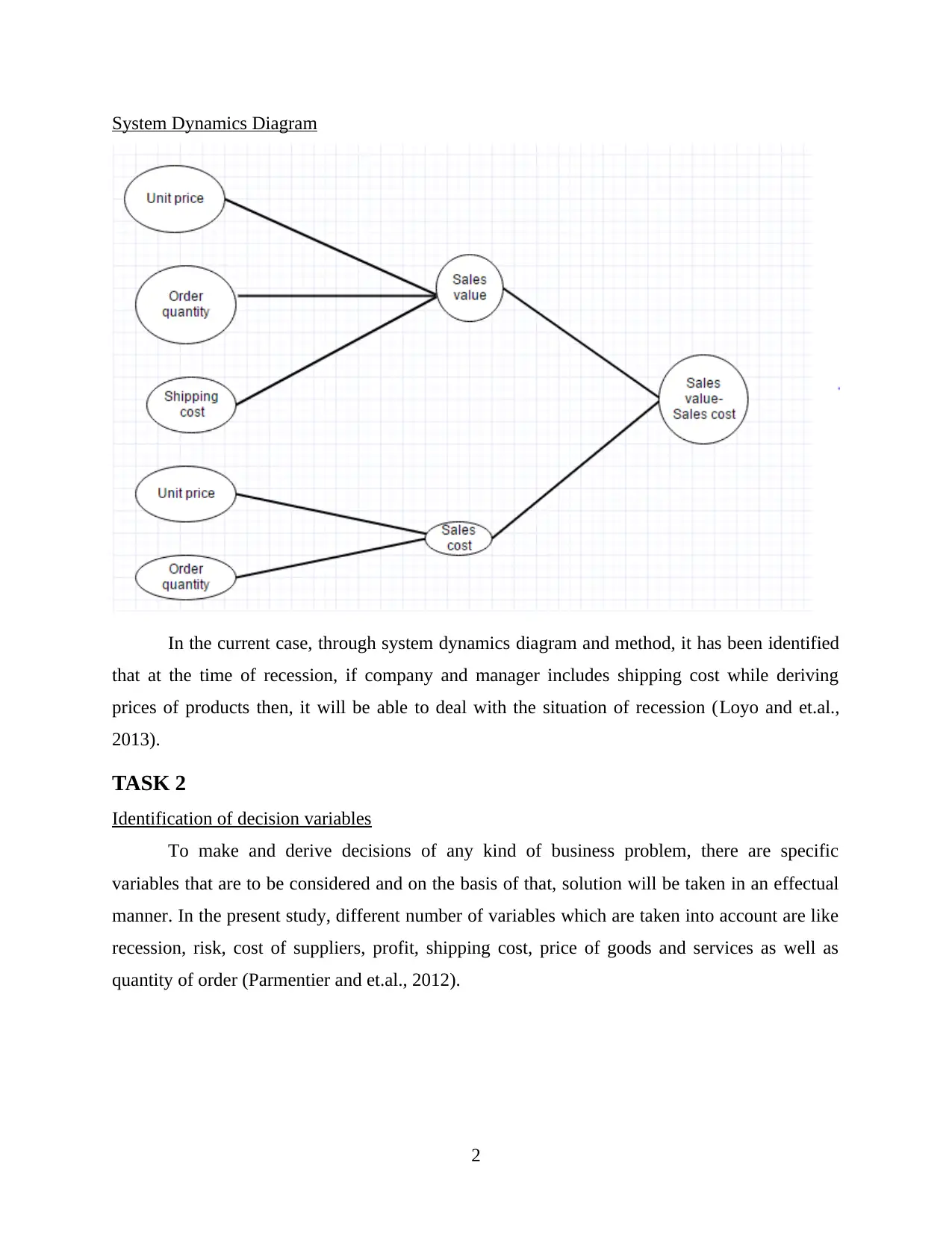
System Dynamics Diagram
In the current case, through system dynamics diagram and method, it has been identified
that at the time of recession, if company and manager includes shipping cost while deriving
prices of products then, it will be able to deal with the situation of recession (Loyo and et.al.,
2013).
TASK 2
Identification of decision variables
To make and derive decisions of any kind of business problem, there are specific
variables that are to be considered and on the basis of that, solution will be taken in an effectual
manner. In the present study, different number of variables which are taken into account are like
recession, risk, cost of suppliers, profit, shipping cost, price of goods and services as well as
quantity of order (Parmentier and et.al., 2012).
2
In the current case, through system dynamics diagram and method, it has been identified
that at the time of recession, if company and manager includes shipping cost while deriving
prices of products then, it will be able to deal with the situation of recession (Loyo and et.al.,
2013).
TASK 2
Identification of decision variables
To make and derive decisions of any kind of business problem, there are specific
variables that are to be considered and on the basis of that, solution will be taken in an effectual
manner. In the present study, different number of variables which are taken into account are like
recession, risk, cost of suppliers, profit, shipping cost, price of goods and services as well as
quantity of order (Parmentier and et.al., 2012).
2
Paraphrase This Document
Need a fresh take? Get an instant paraphrase of this document with our AI Paraphraser
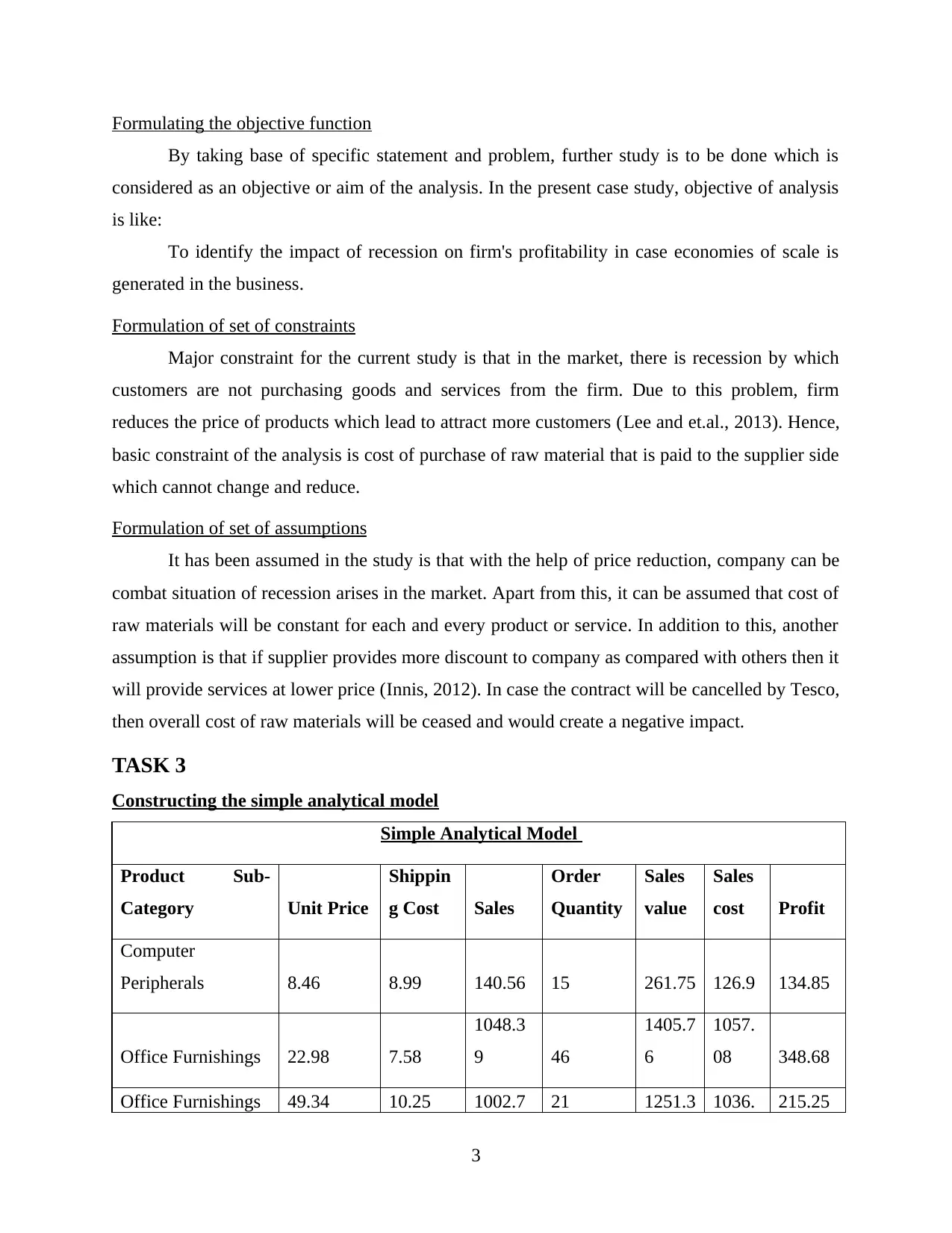
Formulating the objective function
By taking base of specific statement and problem, further study is to be done which is
considered as an objective or aim of the analysis. In the present case study, objective of analysis
is like:
To identify the impact of recession on firm's profitability in case economies of scale is
generated in the business.
Formulation of set of constraints
Major constraint for the current study is that in the market, there is recession by which
customers are not purchasing goods and services from the firm. Due to this problem, firm
reduces the price of products which lead to attract more customers (Lee and et.al., 2013). Hence,
basic constraint of the analysis is cost of purchase of raw material that is paid to the supplier side
which cannot change and reduce.
Formulation of set of assumptions
It has been assumed in the study is that with the help of price reduction, company can be
combat situation of recession arises in the market. Apart from this, it can be assumed that cost of
raw materials will be constant for each and every product or service. In addition to this, another
assumption is that if supplier provides more discount to company as compared with others then it
will provide services at lower price (Innis, 2012). In case the contract will be cancelled by Tesco,
then overall cost of raw materials will be ceased and would create a negative impact.
TASK 3
Constructing the simple analytical model
Simple Analytical Model
Product Sub-
Category Unit Price
Shippin
g Cost Sales
Order
Quantity
Sales
value
Sales
cost Profit
Computer
Peripherals 8.46 8.99 140.56 15 261.75 126.9 134.85
Office Furnishings 22.98 7.58
1048.3
9 46
1405.7
6
1057.
08 348.68
Office Furnishings 49.34 10.25 1002.7 21 1251.3 1036. 215.25
3
By taking base of specific statement and problem, further study is to be done which is
considered as an objective or aim of the analysis. In the present case study, objective of analysis
is like:
To identify the impact of recession on firm's profitability in case economies of scale is
generated in the business.
Formulation of set of constraints
Major constraint for the current study is that in the market, there is recession by which
customers are not purchasing goods and services from the firm. Due to this problem, firm
reduces the price of products which lead to attract more customers (Lee and et.al., 2013). Hence,
basic constraint of the analysis is cost of purchase of raw material that is paid to the supplier side
which cannot change and reduce.
Formulation of set of assumptions
It has been assumed in the study is that with the help of price reduction, company can be
combat situation of recession arises in the market. Apart from this, it can be assumed that cost of
raw materials will be constant for each and every product or service. In addition to this, another
assumption is that if supplier provides more discount to company as compared with others then it
will provide services at lower price (Innis, 2012). In case the contract will be cancelled by Tesco,
then overall cost of raw materials will be ceased and would create a negative impact.
TASK 3
Constructing the simple analytical model
Simple Analytical Model
Product Sub-
Category Unit Price
Shippin
g Cost Sales
Order
Quantity
Sales
value
Sales
cost Profit
Computer
Peripherals 8.46 8.99 140.56 15 261.75 126.9 134.85
Office Furnishings 22.98 7.58
1048.3
9 46
1405.7
6
1057.
08 348.68
Office Furnishings 49.34 10.25 1002.7 21 1251.3 1036. 215.25
3
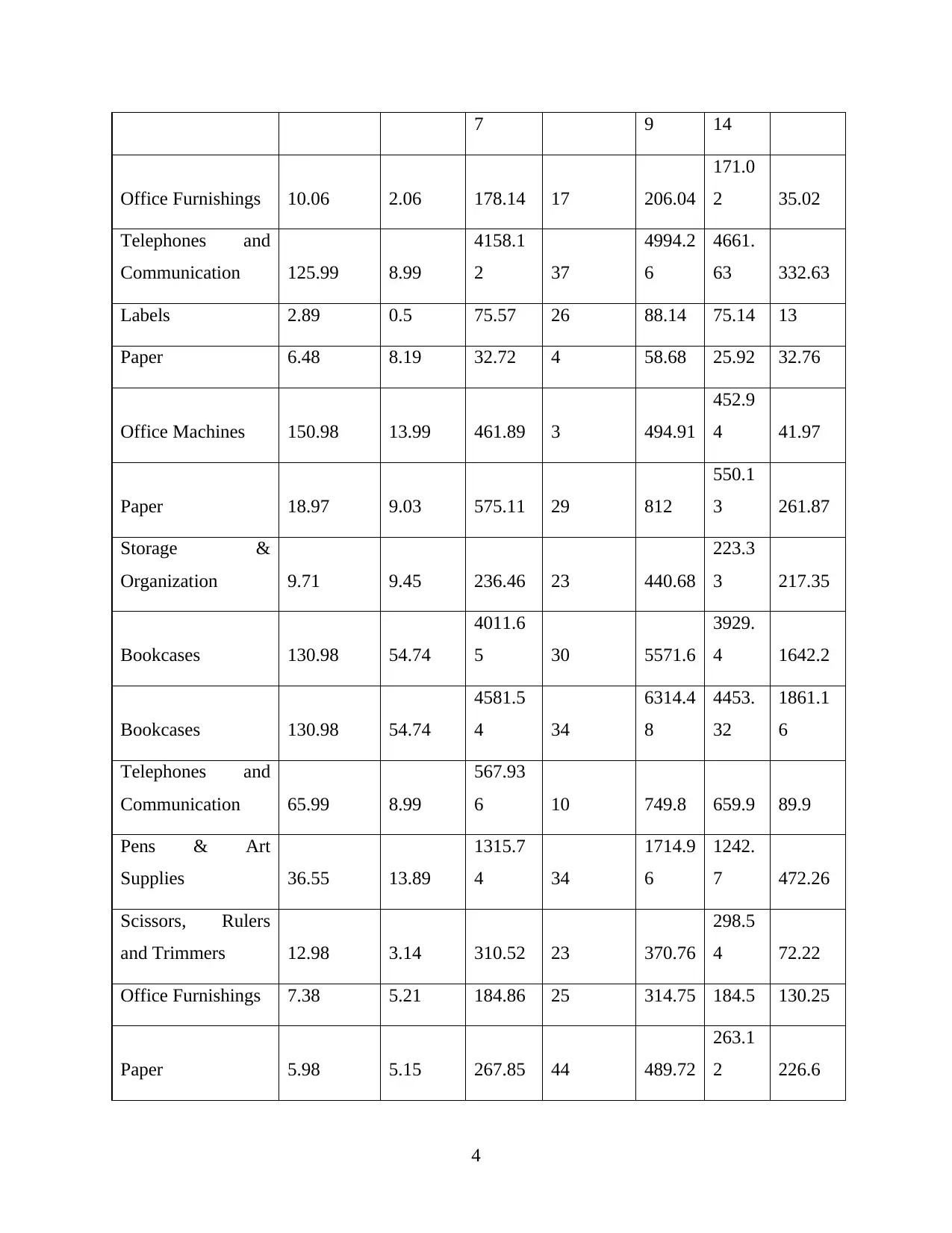
7 9 14
Office Furnishings 10.06 2.06 178.14 17 206.04
171.0
2 35.02
Telephones and
Communication 125.99 8.99
4158.1
2 37
4994.2
6
4661.
63 332.63
Labels 2.89 0.5 75.57 26 88.14 75.14 13
Paper 6.48 8.19 32.72 4 58.68 25.92 32.76
Office Machines 150.98 13.99 461.89 3 494.91
452.9
4 41.97
Paper 18.97 9.03 575.11 29 812
550.1
3 261.87
Storage &
Organization 9.71 9.45 236.46 23 440.68
223.3
3 217.35
Bookcases 130.98 54.74
4011.6
5 30 5571.6
3929.
4 1642.2
Bookcases 130.98 54.74
4581.5
4 34
6314.4
8
4453.
32
1861.1
6
Telephones and
Communication 65.99 8.99
567.93
6 10 749.8 659.9 89.9
Pens & Art
Supplies 36.55 13.89
1315.7
4 34
1714.9
6
1242.
7 472.26
Scissors, Rulers
and Trimmers 12.98 3.14 310.52 23 370.76
298.5
4 72.22
Office Furnishings 7.38 5.21 184.86 25 314.75 184.5 130.25
Paper 5.98 5.15 267.85 44 489.72
263.1
2 226.6
4
Office Furnishings 10.06 2.06 178.14 17 206.04
171.0
2 35.02
Telephones and
Communication 125.99 8.99
4158.1
2 37
4994.2
6
4661.
63 332.63
Labels 2.89 0.5 75.57 26 88.14 75.14 13
Paper 6.48 8.19 32.72 4 58.68 25.92 32.76
Office Machines 150.98 13.99 461.89 3 494.91
452.9
4 41.97
Paper 18.97 9.03 575.11 29 812
550.1
3 261.87
Storage &
Organization 9.71 9.45 236.46 23 440.68
223.3
3 217.35
Bookcases 130.98 54.74
4011.6
5 30 5571.6
3929.
4 1642.2
Bookcases 130.98 54.74
4581.5
4 34
6314.4
8
4453.
32
1861.1
6
Telephones and
Communication 65.99 8.99
567.93
6 10 749.8 659.9 89.9
Pens & Art
Supplies 36.55 13.89
1315.7
4 34
1714.9
6
1242.
7 472.26
Scissors, Rulers
and Trimmers 12.98 3.14 310.52 23 370.76
298.5
4 72.22
Office Furnishings 7.38 5.21 184.86 25 314.75 184.5 130.25
Paper 5.98 5.15 267.85 44 489.72
263.1
2 226.6
4
⊘ This is a preview!⊘
Do you want full access?
Subscribe today to unlock all pages.

Trusted by 1+ million students worldwide
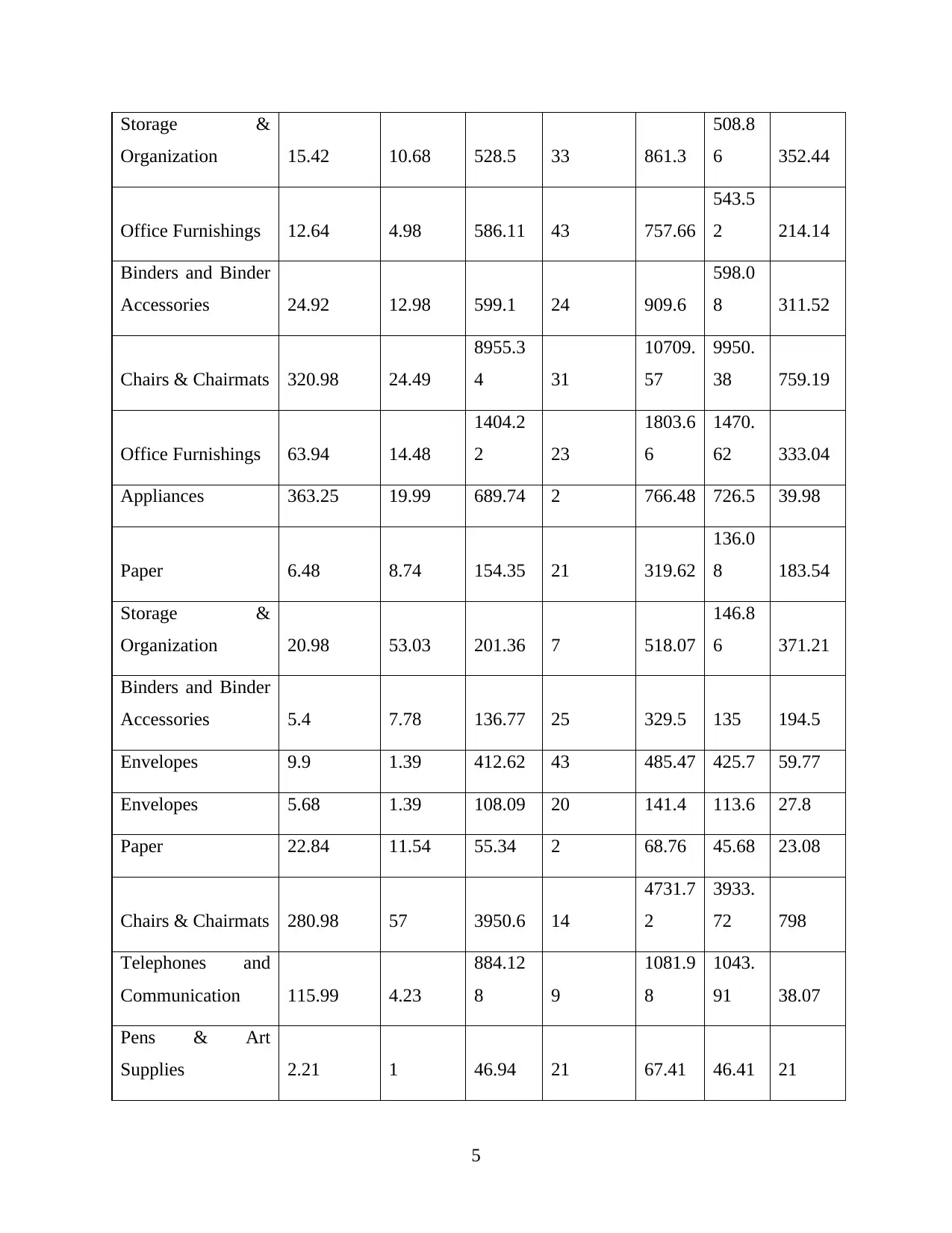
Storage &
Organization 15.42 10.68 528.5 33 861.3
508.8
6 352.44
Office Furnishings 12.64 4.98 586.11 43 757.66
543.5
2 214.14
Binders and Binder
Accessories 24.92 12.98 599.1 24 909.6
598.0
8 311.52
Chairs & Chairmats 320.98 24.49
8955.3
4 31
10709.
57
9950.
38 759.19
Office Furnishings 63.94 14.48
1404.2
2 23
1803.6
6
1470.
62 333.04
Appliances 363.25 19.99 689.74 2 766.48 726.5 39.98
Paper 6.48 8.74 154.35 21 319.62
136.0
8 183.54
Storage &
Organization 20.98 53.03 201.36 7 518.07
146.8
6 371.21
Binders and Binder
Accessories 5.4 7.78 136.77 25 329.5 135 194.5
Envelopes 9.9 1.39 412.62 43 485.47 425.7 59.77
Envelopes 5.68 1.39 108.09 20 141.4 113.6 27.8
Paper 22.84 11.54 55.34 2 68.76 45.68 23.08
Chairs & Chairmats 280.98 57 3950.6 14
4731.7
2
3933.
72 798
Telephones and
Communication 115.99 4.23
884.12
8 9
1081.9
8
1043.
91 38.07
Pens & Art
Supplies 2.21 1 46.94 21 67.41 46.41 21
5
Organization 15.42 10.68 528.5 33 861.3
508.8
6 352.44
Office Furnishings 12.64 4.98 586.11 43 757.66
543.5
2 214.14
Binders and Binder
Accessories 24.92 12.98 599.1 24 909.6
598.0
8 311.52
Chairs & Chairmats 320.98 24.49
8955.3
4 31
10709.
57
9950.
38 759.19
Office Furnishings 63.94 14.48
1404.2
2 23
1803.6
6
1470.
62 333.04
Appliances 363.25 19.99 689.74 2 766.48 726.5 39.98
Paper 6.48 8.74 154.35 21 319.62
136.0
8 183.54
Storage &
Organization 20.98 53.03 201.36 7 518.07
146.8
6 371.21
Binders and Binder
Accessories 5.4 7.78 136.77 25 329.5 135 194.5
Envelopes 9.9 1.39 412.62 43 485.47 425.7 59.77
Envelopes 5.68 1.39 108.09 20 141.4 113.6 27.8
Paper 22.84 11.54 55.34 2 68.76 45.68 23.08
Chairs & Chairmats 280.98 57 3950.6 14
4731.7
2
3933.
72 798
Telephones and
Communication 115.99 4.23
884.12
8 9
1081.9
8
1043.
91 38.07
Pens & Art
Supplies 2.21 1 46.94 21 67.41 46.41 21
5
Paraphrase This Document
Need a fresh take? Get an instant paraphrase of this document with our AI Paraphraser
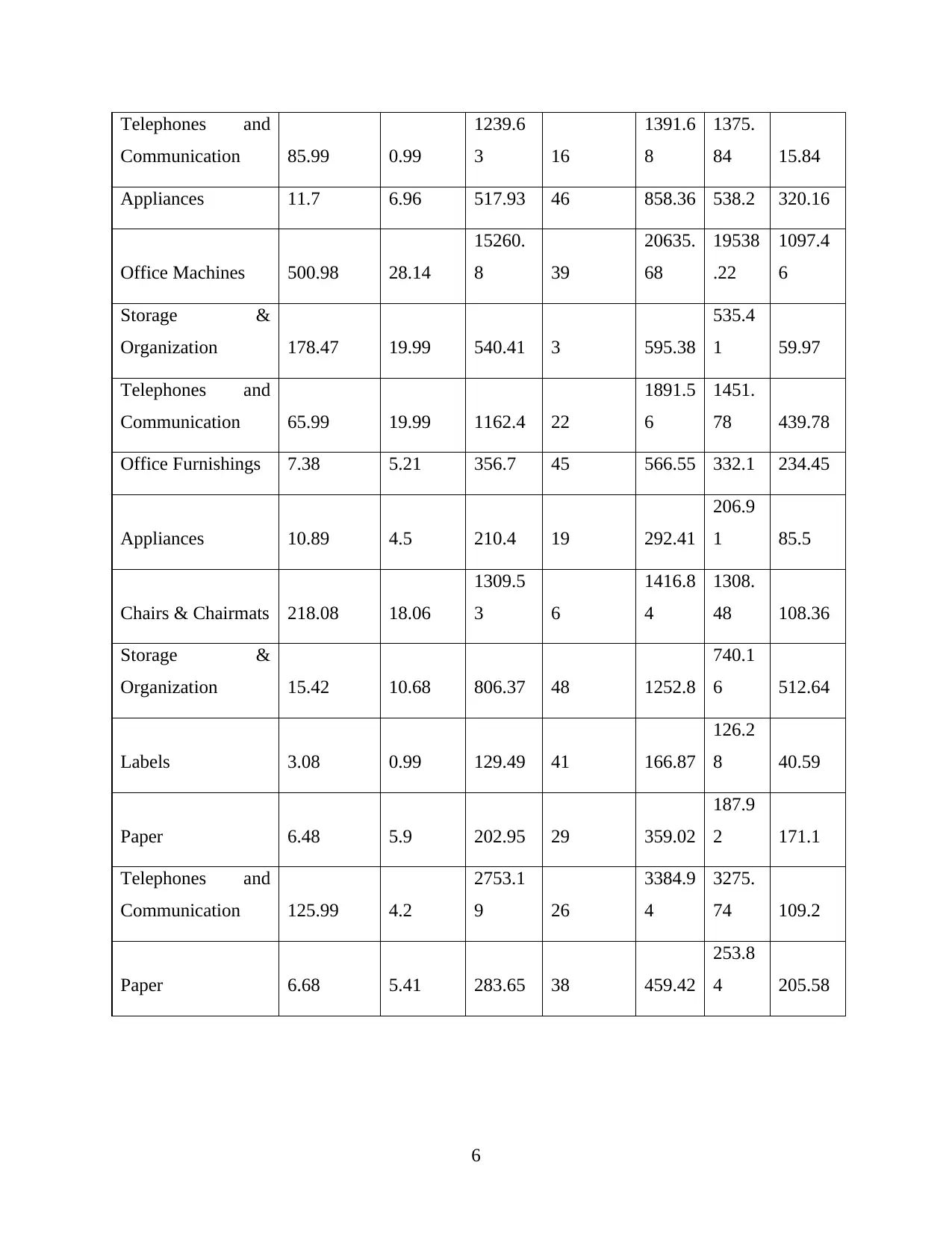
Telephones and
Communication 85.99 0.99
1239.6
3 16
1391.6
8
1375.
84 15.84
Appliances 11.7 6.96 517.93 46 858.36 538.2 320.16
Office Machines 500.98 28.14
15260.
8 39
20635.
68
19538
.22
1097.4
6
Storage &
Organization 178.47 19.99 540.41 3 595.38
535.4
1 59.97
Telephones and
Communication 65.99 19.99 1162.4 22
1891.5
6
1451.
78 439.78
Office Furnishings 7.38 5.21 356.7 45 566.55 332.1 234.45
Appliances 10.89 4.5 210.4 19 292.41
206.9
1 85.5
Chairs & Chairmats 218.08 18.06
1309.5
3 6
1416.8
4
1308.
48 108.36
Storage &
Organization 15.42 10.68 806.37 48 1252.8
740.1
6 512.64
Labels 3.08 0.99 129.49 41 166.87
126.2
8 40.59
Paper 6.48 5.9 202.95 29 359.02
187.9
2 171.1
Telephones and
Communication 125.99 4.2
2753.1
9 26
3384.9
4
3275.
74 109.2
Paper 6.68 5.41 283.65 38 459.42
253.8
4 205.58
6
Communication 85.99 0.99
1239.6
3 16
1391.6
8
1375.
84 15.84
Appliances 11.7 6.96 517.93 46 858.36 538.2 320.16
Office Machines 500.98 28.14
15260.
8 39
20635.
68
19538
.22
1097.4
6
Storage &
Organization 178.47 19.99 540.41 3 595.38
535.4
1 59.97
Telephones and
Communication 65.99 19.99 1162.4 22
1891.5
6
1451.
78 439.78
Office Furnishings 7.38 5.21 356.7 45 566.55 332.1 234.45
Appliances 10.89 4.5 210.4 19 292.41
206.9
1 85.5
Chairs & Chairmats 218.08 18.06
1309.5
3 6
1416.8
4
1308.
48 108.36
Storage &
Organization 15.42 10.68 806.37 48 1252.8
740.1
6 512.64
Labels 3.08 0.99 129.49 41 166.87
126.2
8 40.59
Paper 6.48 5.9 202.95 29 359.02
187.9
2 171.1
Telephones and
Communication 125.99 4.2
2753.1
9 26
3384.9
4
3275.
74 109.2
Paper 6.68 5.41 283.65 38 459.42
253.8
4 205.58
6
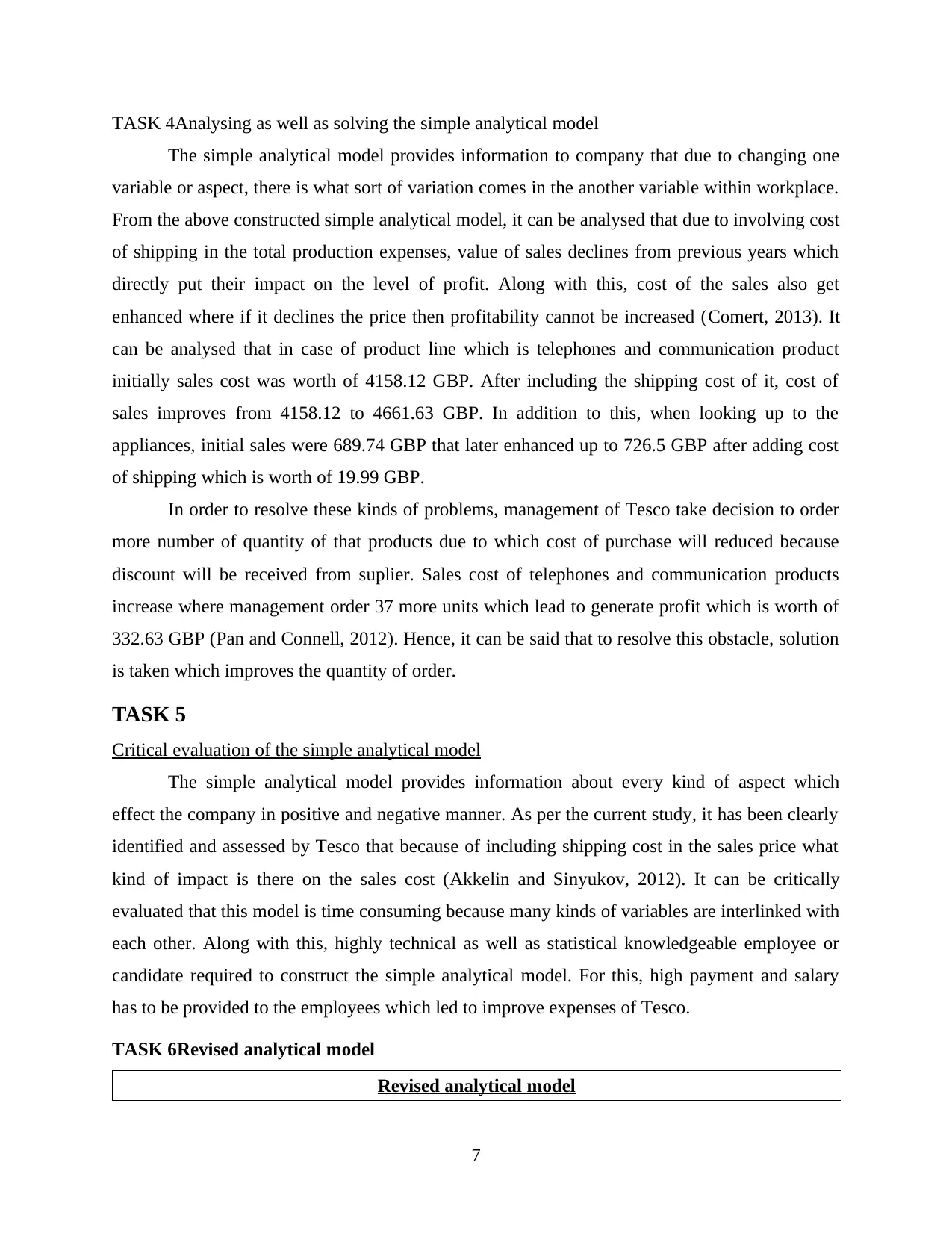
TASK 4Analysing as well as solving the simple analytical model
The simple analytical model provides information to company that due to changing one
variable or aspect, there is what sort of variation comes in the another variable within workplace.
From the above constructed simple analytical model, it can be analysed that due to involving cost
of shipping in the total production expenses, value of sales declines from previous years which
directly put their impact on the level of profit. Along with this, cost of the sales also get
enhanced where if it declines the price then profitability cannot be increased (Comert, 2013). It
can be analysed that in case of product line which is telephones and communication product
initially sales cost was worth of 4158.12 GBP. After including the shipping cost of it, cost of
sales improves from 4158.12 to 4661.63 GBP. In addition to this, when looking up to the
appliances, initial sales were 689.74 GBP that later enhanced up to 726.5 GBP after adding cost
of shipping which is worth of 19.99 GBP.
In order to resolve these kinds of problems, management of Tesco take decision to order
more number of quantity of that products due to which cost of purchase will reduced because
discount will be received from suplier. Sales cost of telephones and communication products
increase where management order 37 more units which lead to generate profit which is worth of
332.63 GBP (Pan and Connell, 2012). Hence, it can be said that to resolve this obstacle, solution
is taken which improves the quantity of order.
TASK 5
Critical evaluation of the simple analytical model
The simple analytical model provides information about every kind of aspect which
effect the company in positive and negative manner. As per the current study, it has been clearly
identified and assessed by Tesco that because of including shipping cost in the sales price what
kind of impact is there on the sales cost (Akkelin and Sinyukov, 2012). It can be critically
evaluated that this model is time consuming because many kinds of variables are interlinked with
each other. Along with this, highly technical as well as statistical knowledgeable employee or
candidate required to construct the simple analytical model. For this, high payment and salary
has to be provided to the employees which led to improve expenses of Tesco.
TASK 6Revised analytical model
Revised analytical model
7
The simple analytical model provides information to company that due to changing one
variable or aspect, there is what sort of variation comes in the another variable within workplace.
From the above constructed simple analytical model, it can be analysed that due to involving cost
of shipping in the total production expenses, value of sales declines from previous years which
directly put their impact on the level of profit. Along with this, cost of the sales also get
enhanced where if it declines the price then profitability cannot be increased (Comert, 2013). It
can be analysed that in case of product line which is telephones and communication product
initially sales cost was worth of 4158.12 GBP. After including the shipping cost of it, cost of
sales improves from 4158.12 to 4661.63 GBP. In addition to this, when looking up to the
appliances, initial sales were 689.74 GBP that later enhanced up to 726.5 GBP after adding cost
of shipping which is worth of 19.99 GBP.
In order to resolve these kinds of problems, management of Tesco take decision to order
more number of quantity of that products due to which cost of purchase will reduced because
discount will be received from suplier. Sales cost of telephones and communication products
increase where management order 37 more units which lead to generate profit which is worth of
332.63 GBP (Pan and Connell, 2012). Hence, it can be said that to resolve this obstacle, solution
is taken which improves the quantity of order.
TASK 5
Critical evaluation of the simple analytical model
The simple analytical model provides information about every kind of aspect which
effect the company in positive and negative manner. As per the current study, it has been clearly
identified and assessed by Tesco that because of including shipping cost in the sales price what
kind of impact is there on the sales cost (Akkelin and Sinyukov, 2012). It can be critically
evaluated that this model is time consuming because many kinds of variables are interlinked with
each other. Along with this, highly technical as well as statistical knowledgeable employee or
candidate required to construct the simple analytical model. For this, high payment and salary
has to be provided to the employees which led to improve expenses of Tesco.
TASK 6Revised analytical model
Revised analytical model
7
⊘ This is a preview!⊘
Do you want full access?
Subscribe today to unlock all pages.

Trusted by 1+ million students worldwide
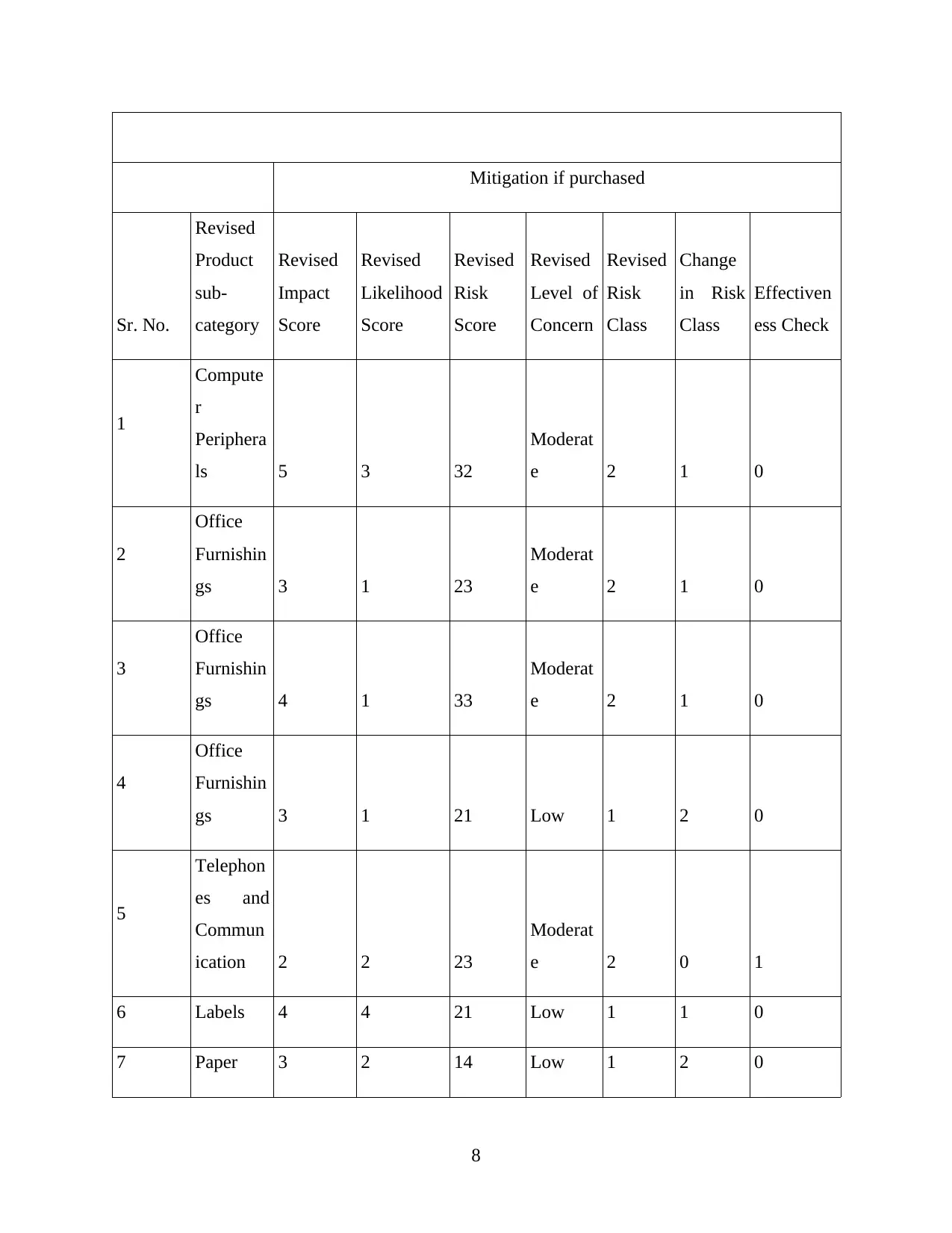
Mitigation if purchased
Sr. No.
Revised
Product
sub-
category
Revised
Impact
Score
Revised
Likelihood
Score
Revised
Risk
Score
Revised
Level of
Concern
Revised
Risk
Class
Change
in Risk
Class
Effectiven
ess Check
1
Compute
r
Periphera
ls 5 3 32
Moderat
e 2 1 0
2
Office
Furnishin
gs 3 1 23
Moderat
e 2 1 0
3
Office
Furnishin
gs 4 1 33
Moderat
e 2 1 0
4
Office
Furnishin
gs 3 1 21 Low 1 2 0
5
Telephon
es and
Commun
ication 2 2 23
Moderat
e 2 0 1
6 Labels 4 4 21 Low 1 1 0
7 Paper 3 2 14 Low 1 2 0
8
Sr. No.
Revised
Product
sub-
category
Revised
Impact
Score
Revised
Likelihood
Score
Revised
Risk
Score
Revised
Level of
Concern
Revised
Risk
Class
Change
in Risk
Class
Effectiven
ess Check
1
Compute
r
Periphera
ls 5 3 32
Moderat
e 2 1 0
2
Office
Furnishin
gs 3 1 23
Moderat
e 2 1 0
3
Office
Furnishin
gs 4 1 33
Moderat
e 2 1 0
4
Office
Furnishin
gs 3 1 21 Low 1 2 0
5
Telephon
es and
Commun
ication 2 2 23
Moderat
e 2 0 1
6 Labels 4 4 21 Low 1 1 0
7 Paper 3 2 14 Low 1 2 0
8
Paraphrase This Document
Need a fresh take? Get an instant paraphrase of this document with our AI Paraphraser
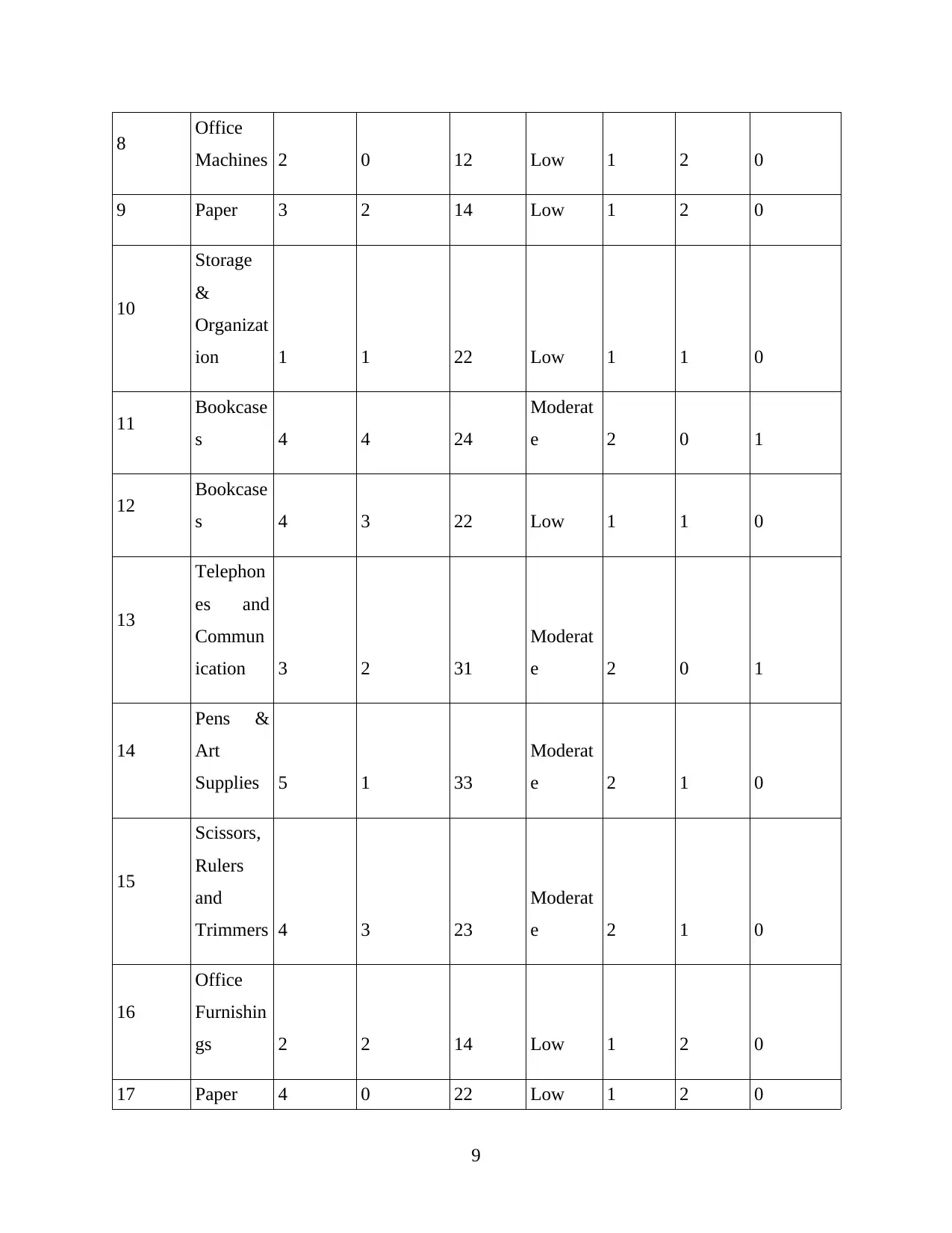
8 Office
Machines 2 0 12 Low 1 2 0
9 Paper 3 2 14 Low 1 2 0
10
Storage
&
Organizat
ion 1 1 22 Low 1 1 0
11 Bookcase
s 4 4 24
Moderat
e 2 0 1
12 Bookcase
s 4 3 22 Low 1 1 0
13
Telephon
es and
Commun
ication 3 2 31
Moderat
e 2 0 1
14
Pens &
Art
Supplies 5 1 33
Moderat
e 2 1 0
15
Scissors,
Rulers
and
Trimmers 4 3 23
Moderat
e 2 1 0
16
Office
Furnishin
gs 2 2 14 Low 1 2 0
17 Paper 4 0 22 Low 1 2 0
9
Machines 2 0 12 Low 1 2 0
9 Paper 3 2 14 Low 1 2 0
10
Storage
&
Organizat
ion 1 1 22 Low 1 1 0
11 Bookcase
s 4 4 24
Moderat
e 2 0 1
12 Bookcase
s 4 3 22 Low 1 1 0
13
Telephon
es and
Commun
ication 3 2 31
Moderat
e 2 0 1
14
Pens &
Art
Supplies 5 1 33
Moderat
e 2 1 0
15
Scissors,
Rulers
and
Trimmers 4 3 23
Moderat
e 2 1 0
16
Office
Furnishin
gs 2 2 14 Low 1 2 0
17 Paper 4 0 22 Low 1 2 0
9
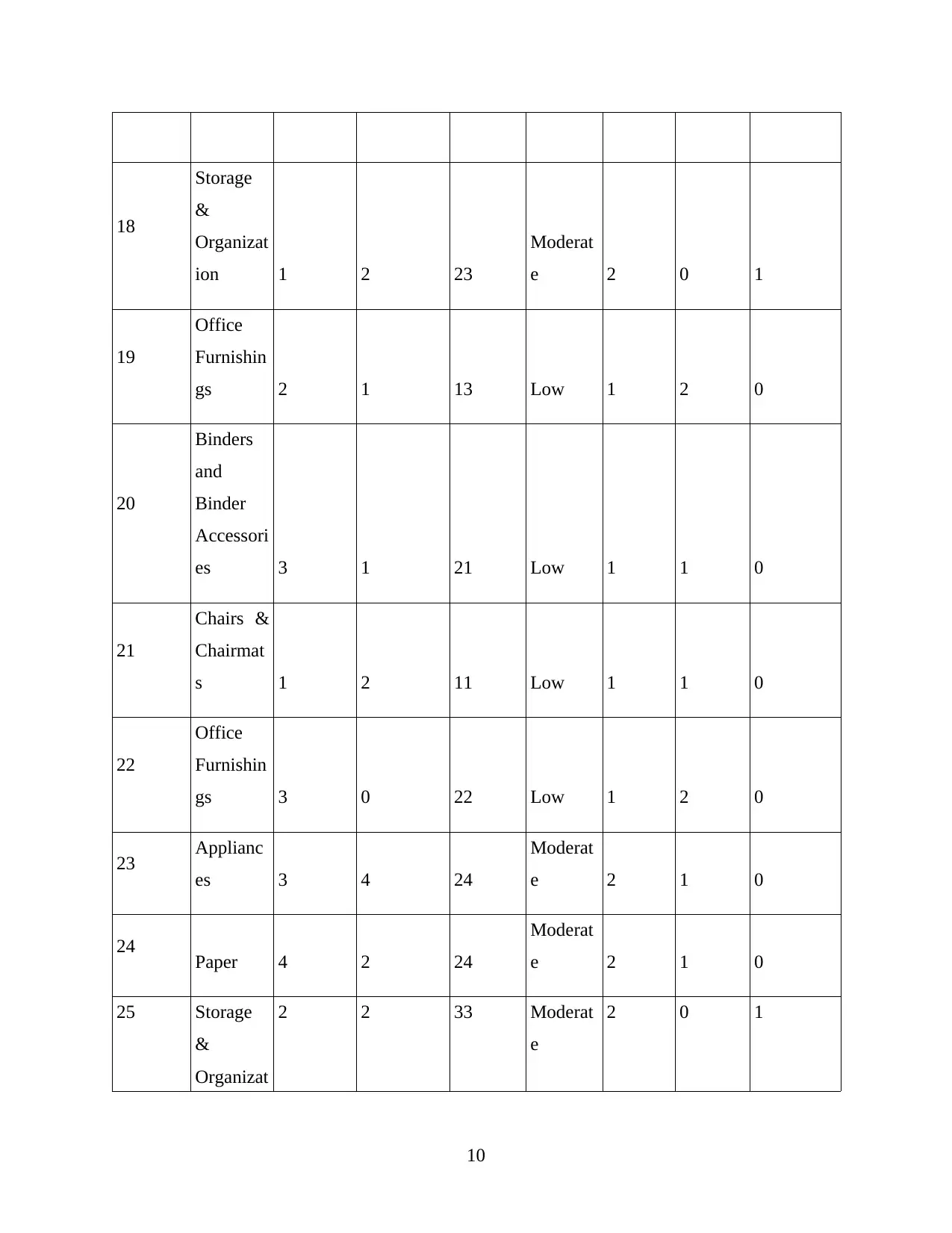
18
Storage
&
Organizat
ion 1 2 23
Moderat
e 2 0 1
19
Office
Furnishin
gs 2 1 13 Low 1 2 0
20
Binders
and
Binder
Accessori
es 3 1 21 Low 1 1 0
21
Chairs &
Chairmat
s 1 2 11 Low 1 1 0
22
Office
Furnishin
gs 3 0 22 Low 1 2 0
23 Applianc
es 3 4 24
Moderat
e 2 1 0
24 Paper 4 2 24
Moderat
e 2 1 0
25 Storage
&
Organizat
2 2 33 Moderat
e
2 0 1
10
Storage
&
Organizat
ion 1 2 23
Moderat
e 2 0 1
19
Office
Furnishin
gs 2 1 13 Low 1 2 0
20
Binders
and
Binder
Accessori
es 3 1 21 Low 1 1 0
21
Chairs &
Chairmat
s 1 2 11 Low 1 1 0
22
Office
Furnishin
gs 3 0 22 Low 1 2 0
23 Applianc
es 3 4 24
Moderat
e 2 1 0
24 Paper 4 2 24
Moderat
e 2 1 0
25 Storage
&
Organizat
2 2 33 Moderat
e
2 0 1
10
⊘ This is a preview!⊘
Do you want full access?
Subscribe today to unlock all pages.

Trusted by 1+ million students worldwide
1 out of 20
Related Documents
Your All-in-One AI-Powered Toolkit for Academic Success.
+13062052269
info@desklib.com
Available 24*7 on WhatsApp / Email
![[object Object]](/_next/static/media/star-bottom.7253800d.svg)
Unlock your academic potential
Copyright © 2020–2025 A2Z Services. All Rights Reserved. Developed and managed by ZUCOL.





